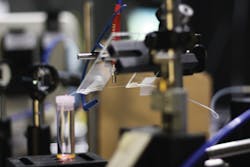GENOMICS/BIOIMAGING: Liquid laser improves detectability of diseased DNA
With conventional fluorescence, the signal from mutated DNA might be only a few tenths of a percent higher than the background noise. But with a liquid laser approach developed by Xudong Fan, associate professor in Biomedical Engineering at the University of Michigan (Ann Arbor, MI), it's hundreds of times brighter. The work could advance understanding of the genetic basis of diseases, and also has applications in personalized medicine.1
The standard approach uses fluorescent dye and other biomolecules to bind to mutated DNA. However, the molecules bind to healthy DNA as well, giving off a background glow that is only slightly dimmer. Failure to discern the difference could yield misdiagnosis.
Fan has spent the past five years developing liquid lasers, which amplify light by passing it through a dye in a glass capillary called a ring resonator cavity. Last year, his research group found that they could use DNA to modulate a liquid laser, or turn it on and off. Looking at the laser output enabled him and his team to see what's causing the different outputs, thereby enabling them to detect differences in the DNA. Currently, the university is pursuing patent protection for the intellectual property, and is seeking commercialization partners to help bring the technology to market.
1. Y. Sun and X. Fan, Ang. Chem. Int. Ed., 51, 5, 1236–1239 (2012).
More BioOptics World Current Issue Articles
More BioOptics World Archives Issue Articles
